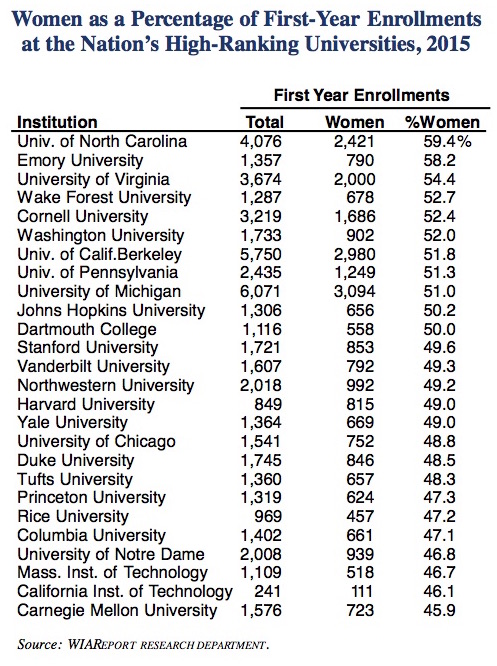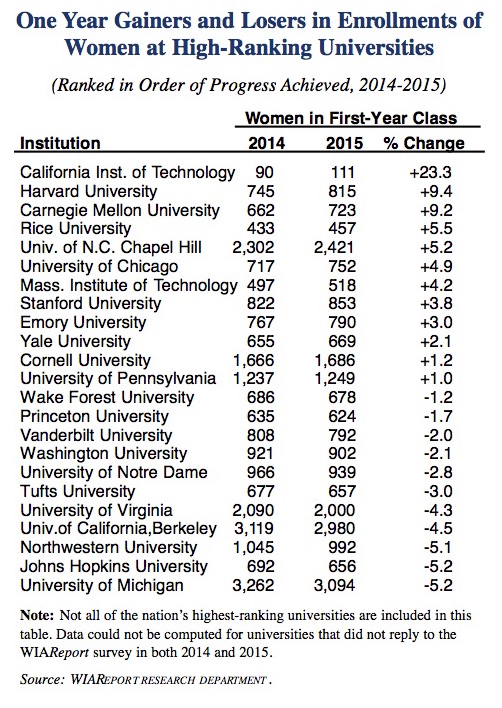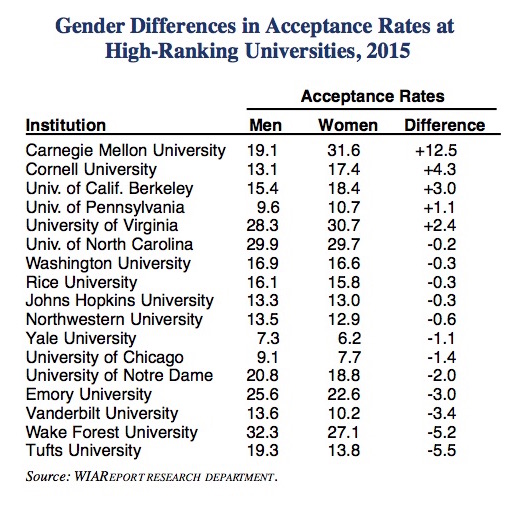First-Year Women at the Nation’s Leading Research Universities
Posted on Jan 05, 2016 | Comments 0
![]() For the fifth year in a row, WIAReport has surveyed the nation’s highest-ranking research universities to determine the percentage of women in this year’s entering classes. We also report on gender differences in acceptance rates at these schools and whether women have made gains in enrollments at these colleges compared to where they were a year ago.
For the fifth year in a row, WIAReport has surveyed the nation’s highest-ranking research universities to determine the percentage of women in this year’s entering classes. We also report on gender differences in acceptance rates at these schools and whether women have made gains in enrollments at these colleges compared to where they were a year ago.
Of the 26 high-ranking universities that responded to our survey, women were a majority of the entering students at 11 schools. A year ago, were a majority of the first-year students at 13 high-ranking universities. Two years ago, women were a majority of the first-year students at 17 of the 28 universities that responded to our survey
There are wide variations in the percentage of women in the first-year classes at these highly rated universities. For the fifth year in a row, the highest percentage of women in the entering class among this large group of leading research universities is found at the University of North Carolina at Chapel Hill. There are 2,421 women among the 4,076 entering students at UNC this fall. Thus, women make up more than 59 percent of all first-year students.
Emory University in Atlanta has the second-highest percentage of women in its entering class among this group of leading research universities. Emory was third last year after ranking second the previous two years. This year women make up 58.2 percent of the entering class. The University of Virginia, which ranked second last year, drops to third. Women are 54.4 percent of the first-year class at the University of Virginia. At Cornell University, Washington University, and Wake Forest University, women make up more than 52 percent of the entering students.
At the other extreme, Carnegie Mellon University in Pittsburgh has an entering class where women make up 45.9 percent of all first-year students. This is the lowest percentage among high-ranking universities that responded to our survey. At the California Institute of Technology, women make up 46.1 percent of the entering students. Last year only 40 percent of the entering students at the California Institute of Technology were women and this was up nearly five percentage points from the previous year. At the Massachusetts Institute of Technology women are 46.7 percent of the first-year class. It is hardly surprising that these three universities have the lowest percentage of women in their entering classes considering that these three schools all have large numbers of students in engineering and other STEM disciplines where historically women have been vastly underrepresented.
We can compare last year’s results to the current data to see where women are making progress. Of the 23 leading universities for which we have data in both years, 12 schools show an increase in the number of women first-year students and 11 show a decline.
We find that the number of women in the entering class at the California Institute of Technology is up 23.3 percent from a year ago, the largest increase in our survey. At the University of Chicago, the number of women in the entering class is up 11.2 percent from a year ago.
Last year there was surprisingly low percentage of women in the entering class at Harvard University. In 2014, women were just under 45 percent of the entering class. This year women make up 49 percent of the entering class. The number of women first-year students is up by more than 9 percent. Carnegie Mellon University also posted a 9 percent increase in the number of women in the entering class.
In contrast, the number of entering women students at the University of Michigan, Johns Hopkins University, and Northwestern University is down by more than 5 percent this year. At the University of Virginia and the University of California, Berkeley the percentage of women in the entering class is down by more than 4 percent.
It is well known that nationwide women outpace men in college enrollments, graduation rates, and degrees earned. Because of a large and growing gender gap in enrollments at many colleges and universities, it has become easier for men to gain admission to some colleges and universities. It must be noted that just because men have a higher acceptance rate than women at a given institution does not necessarily mean that men have received an unfair admissions advantage. A particular college or university may simply have had an outstanding pool of male applicants in a given year.
We do note that many high-ranking universities are reluctant to report gender differences in acceptance rates. We will simply present the data and let readers make their own conclusions.
Of the 17 highly rated research universities that supplied data, we find that women were accepted at a higher rate than men at only five institutions. The greatest difference was at Carnegie Mellon University, which as stated is heavily focused on STEM disciplines. At this highly rated university, 31.6 percent of women were accepted for admission compared to only 19.1 percent of male applicants. Thus, there was a very large acceptance rate gap in favor of women of 12.5 percentage points.
The next highest acceptance rate gap in favor of women was 4 percentage points at Cornell University. The only other leading research university where the accepted rate for women was three percentage points higher than the rate for men was the University of California, Berkeley.
At the other end of the spectrum, Tufts University in Medford, Massachusetts, and Wake Forest University in Winston-Salem, North Carolina, had the highest gender gap in acceptance rates in favor of men. Tufts accepted 19.3 percent of male applicants but only 13.8 percent of women applicants. At Wake Forest, 32.3 percent of male applicants were accepted compared to 27.1 percent of women applicants. Last year, Tufts and Wake Forest also had the highest acceptance rate gaps in favor of men.
At Vanderbilt University in Nashville and Emory University in Atlanta, men were accepted at a rate at least three percentage points higher than women.
Filed Under: Enrollments • Featured











